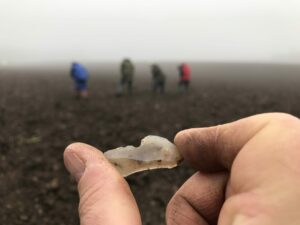
I’ve been thinking about lithic scatters a lot recently. For the uninitiated a lithic scatter is a collection of stone tools. They tend to be found on the ground surface, usually across the surface of a ploughed field, but they may also occur in other places such as within a blowout between eroding sand dunes, in the gravels at the edge of a lake, or along a hillside footpath. Of course, the material that you pick up from the ground is only part of it, the bulk of the pieces from any lithic scatter site will lie within the soil below, whether that is ploughsoil, blown sand or whatever.
Lithic scatters are a reflection of the past presence of human groups, who left behind their debris, most of which has long dissolved away into Scotland’s acid soils. Flint (or other worked stone), being durable, survives. Sadly, the existence of a scatter site is usually testimony that the site itself has succumbed to the processes of nature and people so that in situ remains such as the traces of hut circles or hearths, have long since disappeared. In many cases the stone tools result from several episodes of human activity, often separated by long periods of time, and frequently representing different types of activity. A lithic scatter is rarely the result of a single event, though it can happen.
It may also be the case that below the disturbed upper layers of a scatter site, some material has survived in its original location. For these reasons, it is a complex business to unpick the multiple histories of a scatter site.
It is first necessary to assess the material on the ground surface: how large an area is covered; are there distinct boundaries to the site; what types of find are present? This is usually achieved by fieldwalking, crossing the field, or surface, in transects with the eyes to the ground in order to look for material such as stone flakes. These will usually be picked up, bagged, and the location recorded using a digital Global Positioning System (DGPS). Occasionally finds are left in position on the surface of the field. Fieldwalking is best done on a recently ploughed field that has been left to weather and expose the stone tools. The morning after rain is always good because the flint surface shows nice and shiny when it is wet. Some advocate intense examination on hands and knees, but most people prefer to remain upright and, with practice, it is possible to get your eyes accustomed to spotting even tiny slivers of stone.
Fieldwalking is a good technique because it does not disturb the site itself apart from the removal of material that has already been disturbed. From this analysis it should be possible to provide preliminary information relating to the likely period/s and type/s of site concerned. The next stage is to dig test pits across the field. These comprise small pits usually hand dug and measuring anything around one or two metres square. The aim of test pitting is usually to assess the material within the ploughsoil and look for any archaeological features that may survive intact below the ploughzone. To this end, all, or a sample, of the soil will be sieved in order to locate and remove finds and the surface below the ploughsoil is carefully cleaned by hand.
Where traces of the original site are found, this information can assist management of the site, and may lead to full-scale excavation.
Given the ubiquity of the agricultural landscape across Scotland, and an erosive natural landscape outside farmed areas, it is not surprising to find that scatter sites form one of the most common ways in which archaeological material is to be found. It is also relevant that for much of our past people have not been in the habit of making stone buildings or monuments so that few, if any, upstanding traces of a site will appear on the ground surface.
Nevertheless, despite their importance, scatter sites are generally neglected as an archaeological resource. To date the management powers of bodies such as Historic Environment Scotland make it difficult for scatter sites to be included in any mandatory protection scheme. Many archaeologists regard them as so disturbed and damaged that they are rarely worthy of detailed attention.
I’d like to argue for the significance of scatter sites. They provide an important indication of prehistoric sites which rarely show up on the surface of the ground. They can often mask well-preserved material below ground surface. And, investigation has shown that, with care, it is possible to extract a considerable amount of valuable information from a scatter site. Along the River Dee in Aberdeenshire, the HLF funded work of the admirable Mesolithic Deeside group has shown just how much one group of enthusiastic people can find from scatter sites. By fieldwalking and occasionally test pitting they have discovered a number of new prehistoric sites and contributed much additional detail to our understanding of existing sites.
Some of the Deeside sites have been fieldwalked over a number of years (see here). A few have now been test-pitted and one has seen a major excavation. From this it has also been possible to build an intruiging picture of the way in which archaeological information is constructed. From the initial recovery of some rather nice pieces such as arrowheads and scrapers, to later finds of small microlithic points, and the ubiquitous presence of flint cores, we can see understanding of the archaeology of these particular fields growing over the years. It is a fascinating story and one which archaeology rarely gets the opportunity to uncover.
Scatter sites are a complex archaeological resource, worthy of better attention.
You must be logged in to post a comment.